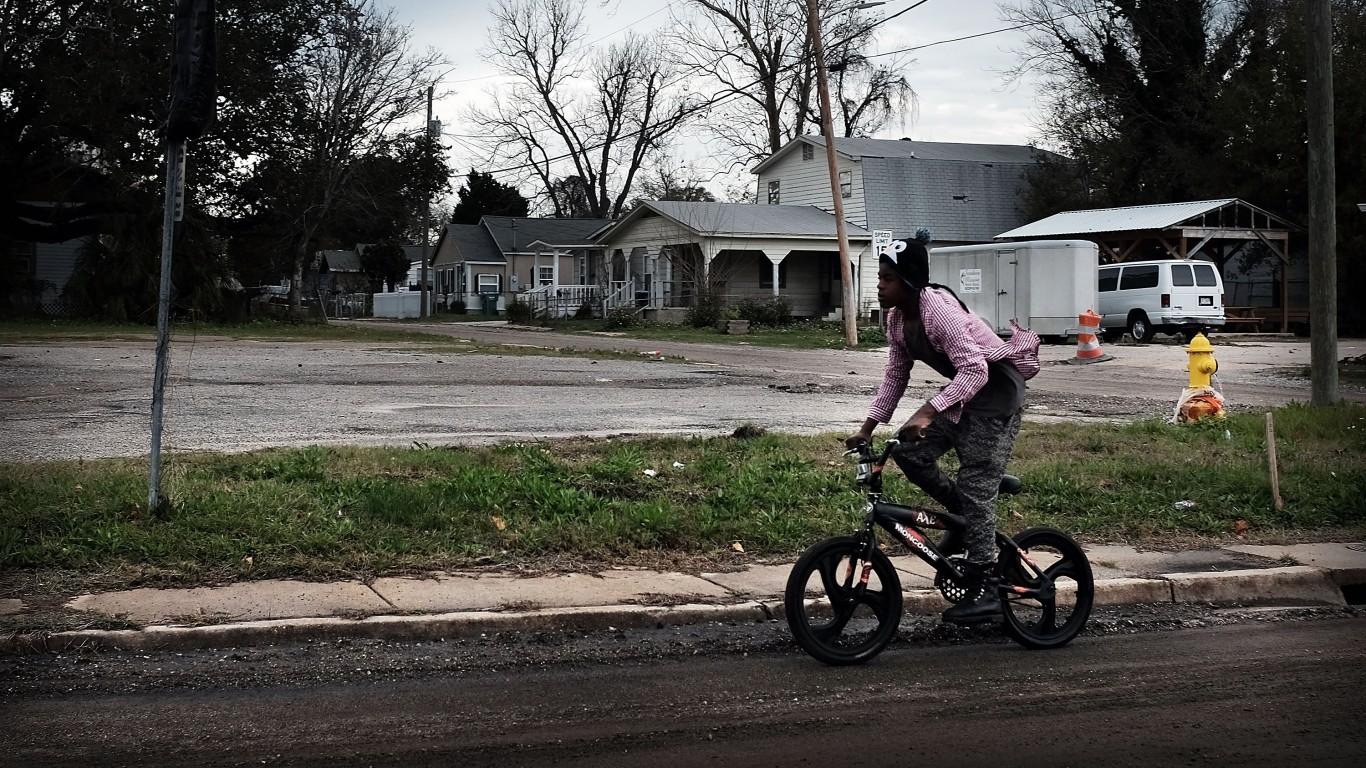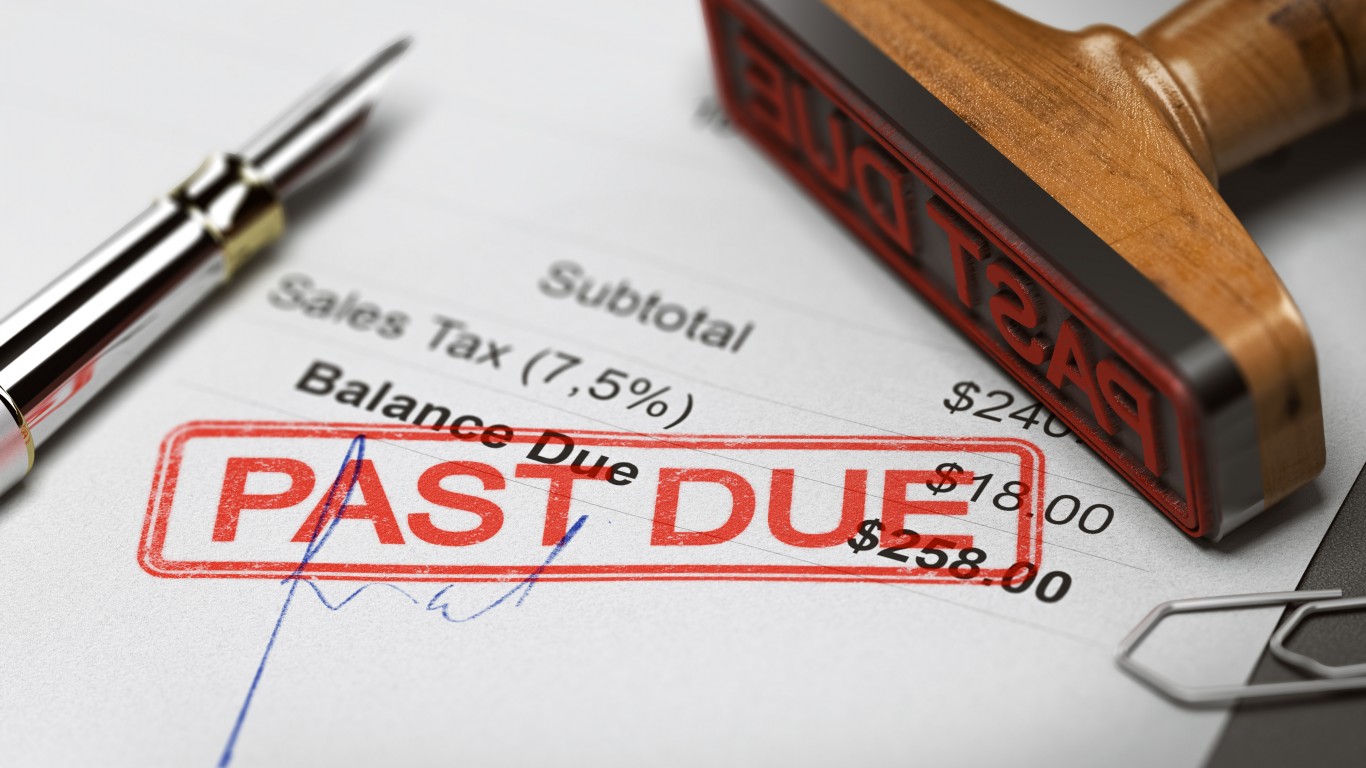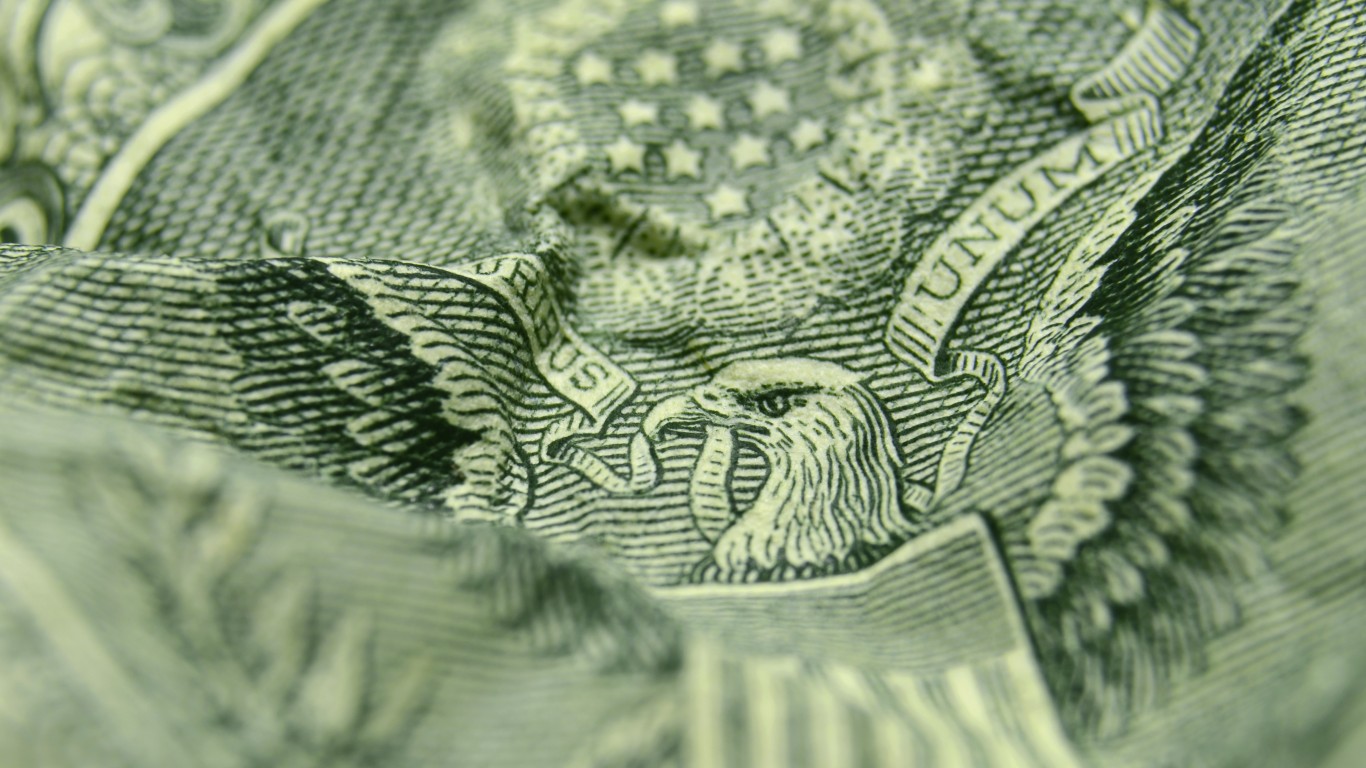
Though the COVID-19 pandemic disrupted many households financially, adding to debt burdens at times, the share of people with debt in collection has very slightly improved and in October 2020 stood at around 29% of people with a credit bureau record, according to the Urban Institute, a nonprofit research organization.
Having debt in collection usually means that after being late on payments, such as for a car loan or a credit card bill, the debt has been sent to a third party — a collection agency — which will aggressively try to collect it. Having debt in collection, needless to say, can be very stressful.
Across states, the share of people with debt in collection ranges from 14.39% to 41.61%, according to the state. States with higher poverty rates and lower incomes tend to have a higher share of people with debt in collection. The median amount of debt in collection ranges from about $1,300 to over $2,500.
Having debt in collection affects a person’s credit score, which can then affect credit availability — a key element in a family’s financial health. A solid credit rating provides access to long-term borrowing for the purchase of large ticket items, such as houses, automobiles, and home furnishings, and to pay for college tuition or handle medical bills.
The absence of good credit, on the other hand, can feed into a cycle of poverty, not only crippling a family’s chances of home ownership and a college education for offspring, but draining already limited resources when borrowing is necessary. A poor credit rating reduces a borrower’s options to “payday loans” and other short-term, high-interest debt. (These are the states where people are struggling with the most debt.)
Not surprisingly, average credit health varies by location. Across the U.S., the average credit score is 704, and credit scores range from an average of 654 in Mississippi to 738 in Minnesota, with the lowest scores found in the states with the highest rates of poverty. (These are the towns with the highest poverty rates in the nation.)
To identify the share of people in each state who have debt in collections, 24/7 Wall St. reviewed data from Urban Institute’s report “Credit Health During the COVID-19 Pandemic,” and ranked each state by the share of people with a credit bureau record with any debt in collections as of October 2020, the latest available. Debt in collections means unpaid bills, fees, credit card debt, and payments referred to collection agencies.
Click here to see the states where the most people are struggling with debt in collection
Additional data sourced from the Urban Institute includes median debt in collections and median credit score per state. The Urban Institute dataset contains information derived from de-identified, consumer-level records from a major credit bureau nationwide, covering the period from February through October, 2020. 24/7 Wall St. added 2019 poverty rate, uninsured rate, and median household income from the U.S. Census Bureau’s 2019 American Community Survey.

50. Minnesota
> Share of people with debt in collection: 14.39%
> Median debt in collection: $1,727 — 18th lowest
> Median credit score: 738 — the highest
> Poverty rate: 8.97% — 3rd lowest
> Median household income 2019: $74,593 — 13th highest
> Uninsured rate: 4.88% — 5th lowest
[in-text-ad]

49. South Dakota
> Share of people with debt in collection: 16.40%
> Median debt in collection: $2,212 — 6th highest
> Median credit score: 725 — 7th highest
> Poverty rate: 11.93% — 23rd highest
> Median household income 2019: $59,533 — 18th lowest
> Uninsured rate: 10.19% — 13th highest

48. North Dakota
> Share of people with debt in collection: 17.43%
> Median debt in collection: $1,914 — 19th highest
> Median credit score: 726 — 5th highest
> Poverty rate: 10.57% — 17th lowest
> Median household income 2019: $64,577 — 20th highest
> Uninsured rate: 6.90% — 19th lowest

47. Washington
> Share of people with debt in collection: 17.68%
> Median debt in collection: $1,856 — 22nd highest
> Median credit score: 725 — 7th highest
> Poverty rate: 9.78% — 9th lowest
> Median household income 2019: $78,687 — 7th highest
> Uninsured rate: 6.62% — 17th lowest
[in-text-ad-2]

46. Vermont
> Share of people with debt in collection: 18.24%
> Median debt in collection: $1,748 — 20th lowest
> Median credit score: 727 — 4th highest
> Poverty rate: 10.17% — 15th lowest
> Median household income 2019: $63,001 — 25th lowest
> Uninsured rate: 4.49% — 4th lowest

45. Massachusetts
> Share of people with debt in collection: 18.59%
> Median debt in collection: $1,584 — 10th lowest
> Median credit score: 729 — 2nd highest
> Poverty rate: 9.40% — 8th lowest
> Median household income 2019: $85,843 — 2nd highest
> Uninsured rate: 2.99% — the lowest
[in-text-ad]

44. Hawaii
> Share of people with debt in collection: 18.93%
> Median debt in collection: $1,926 — 18th highest
> Median credit score: 720 — 11th highest
> Poverty rate: 9.33% — 6th lowest
> Median household income 2019: $83,102 — 4th highest
> Uninsured rate: 4.16% — 3rd lowest

43. Oregon
> Share of people with debt in collection: 19.05%
> Median debt in collection: $1,542 — 5th lowest
> Median credit score: 718 — 13th highest
> Poverty rate: 11.38% — 23rd lowest
> Median household income 2019: $67,058 — 18th highest
> Uninsured rate: 7.17% — 20th lowest

41. New Hampshire
> Share of people with debt in collection: 19.49%
> Median debt in collection: $1,728 — 19th lowest
> Median credit score: 726 — 5th highest
> Poverty rate: 7.27% — the lowest
> Median household income 2019: $77,933 — 8th highest
> Uninsured rate: 6.25% — 13th lowest
[in-text-ad-2]

41. Nebraska
> Share of people with debt in collection: 19.49%
> Median debt in collection: $2,095 — 10th highest
> Median credit score: 722 — 10th highest
> Poverty rate: 9.89% — 10th lowest
> Median household income 2019: $63,229 — 25th highest
> Uninsured rate: 8.29% — 23rd highest

40. Wisconsin
> Share of people with debt in collection: 20.88%
> Median debt in collection: $1,706 — 16th lowest
> Median credit score: 729 — 2nd highest
> Poverty rate: 10.42% — 16th lowest
> Median household income 2019: $64,168 — 21st highest
> Uninsured rate: 5.71% — 8th lowest
[in-text-ad]

39. Utah
> Share of people with debt in collection: 21.41%
> Median debt in collection: $1,966 — 14th highest
> Median credit score: 712 — 18th highest
> Poverty rate: 8.91% — 2nd lowest
> Median household income 2019: $75,780 — 11th highest
> Uninsured rate: 9.65% — 18th highest

38. Idaho
> Share of people with debt in collection: 21.64%
> Median debt in collection: $2,262 — 2nd highest
> Median credit score: 712 — 18th highest
> Poverty rate: 11.17% — 21st lowest
> Median household income 2019: $60,999 — 20th lowest
> Uninsured rate: 10.83% — 12th highest

37. Iowa
> Share of people with debt in collection: 21.87%
> Median debt in collection: $1,677 — 14th lowest
> Median credit score: 724 — 9th highest
> Poverty rate: 11.17% — 20th lowest
> Median household income 2019: $61,691 — 21st lowest
> Uninsured rate: 5.01% — 6th lowest
[in-text-ad-2]

36. Montana
> Share of people with debt in collection: 22.08%
> Median debt in collection: $1,799 — 23rd lowest
> Median credit score: 718 — 13th highest
> Poverty rate: 12.65% — 20th highest
> Median household income 2019: $57,153 — 11th lowest
> Uninsured rate: 8.27% — 24th highest

35. New York
> Share of people with debt in collection: 22.24%
> Median debt in collection: $1,750 — 21st lowest
> Median credit score: 713 — 17th highest
> Poverty rate: 13.03% — 16th highest
> Median household income 2019: $72,108 — 14th highest
> Uninsured rate: 5.24% — 7th lowest
[in-text-ad]

34. California
> Share of people with debt in collection: 23.63%
> Median debt in collection: $1,896 — 20th highest
> Median credit score: 704 — 25th highest
> Poverty rate: 11.75% — 25th highest
> Median household income 2019: $80,440 — 5th highest
> Uninsured rate: 7.70% — 22nd lowest

33. Colorado
> Share of people with debt in collection: 23.65%
> Median debt in collection: $1,637 — 12th lowest
> Median credit score: 720 — 11th highest
> Poverty rate: 9.35% — 7th lowest
> Median household income 2019: $77,127 — 9th highest
> Uninsured rate: 8.01% — 25th lowest

32. Rhode Island
> Share of people with debt in collection: 23.78%
> Median debt in collection: $1,803 — 24th lowest
> Median credit score: 708 — 22nd highest
> Poverty rate: 10.82% — 18th lowest
> Median household income 2019: $71,169 — 15th highest
> Uninsured rate: 4.09% — 2nd lowest
[in-text-ad-2]

31. Connecticut
> Share of people with debt in collection: 24.74%
> Median debt in collection: $1,546 — 6th lowest
> Median credit score: 716 — 15th highest
> Poverty rate: 10.03% — 12th lowest
> Median household income 2019: $78,833 — 6th highest
> Uninsured rate: 5.90% — 11th lowest

30. New Jersey
> Share of people with debt in collection: 24.77%
> Median debt in collection: $1,372 — 2nd lowest
> Median credit score: 711 — 20th highest
> Poverty rate: 9.16% — 5th lowest
> Median household income 2019: $85,751 — 3rd highest
> Uninsured rate: 7.89% — 23rd lowest
[in-text-ad]

29. Pennsylvania
> Share of people with debt in collection: 26.37%
> Median debt in collection: $1,822 — 25th highest
> Median credit score: 716 — 15th highest
> Poverty rate: 12.02% — 22nd highest
> Median household income 2019: $63,463 — 23rd highest
> Uninsured rate: 5.77% — 9th lowest

28. Wyoming
> Share of people with debt in collection: 26.45%
> Median debt in collection: $2,509 — the highest
> Median credit score: 705 — 24th highest
> Poverty rate: 10.11% — 14th lowest
> Median household income 2019: $65,003 — 19th highest
> Uninsured rate: 12.31% — 6th highest

27. Alaska
> Share of people with debt in collection: 26.92%
> Median debt in collection: $2,181 — 7th highest
> Median credit score: 690 — 20th lowest
> Poverty rate: 10.08% — 13th lowest
> Median household income 2019: $75,463 — 12th highest
> Uninsured rate: 12.21% — 7th highest
[in-text-ad-2]

26. Virginia
> Share of people with debt in collection: 27.24%
> Median debt in collection: $1,804 — 25th lowest
> Median credit score: 706 — 23rd highest
> Poverty rate: 9.94% — 11th lowest
> Median household income 2019: $76,456 — 10th highest
> Uninsured rate: 7.93% — 24th lowest

25. Kansas
> Share of people with debt in collection: 27.38%
> Median debt in collection: $1,751 — 22nd lowest
> Median credit score: 704 — 25th highest
> Poverty rate: 11.43% — 24th lowest
> Median household income 2019: $62,087 — 24th lowest
> Uninsured rate: 9.20% — 19th highest
[in-text-ad]

24. Maryland
> Share of people with debt in collection: 27.47%
> Median debt in collection: $1,610 — 11th lowest
> Median credit score: 695 — 22nd lowest
> Poverty rate: 9.02% — 4th lowest
> Median household income 2019: $86,738 — the highest
> Uninsured rate: 6.00% — 12th lowest

23. Maine
> Share of people with debt in collection: 27.66%
> Median debt in collection: $1,691 — 15th lowest
> Median credit score: 711 — 20th highest
> Poverty rate: 10.87% — 19th lowest
> Median household income 2019: $58,924 — 16th lowest
> Uninsured rate: 8.02% — 25th highest

22. Illinois
> Share of people with debt in collection: 27.93%
> Median debt in collection: $1,572 — 8th lowest
> Median credit score: 704 — 25th highest
> Poverty rate: 11.48% — 25th lowest
> Median household income 2019: $69,187 — 17th highest
> Uninsured rate: 7.39% — 21st lowest
[in-text-ad-2]

21. Michigan
> Share of people with debt in collection: 28.67%
> Median debt in collection: $1,502 — 4th lowest
> Median credit score: 703 — 23rd lowest
> Poverty rate: 12.99% — 17th highest
> Median household income 2019: $59,584 — 19th lowest
> Uninsured rate: 5.78% — 10th lowest

20. Arizona
> Share of people with debt in collection: 30.66%
> Median debt in collection: $2,052 — 11th highest
> Median credit score: 684 — 17th lowest
> Poverty rate: 13.47% — 13th highest
> Median household income 2019: $62,055 — 23rd lowest
> Uninsured rate: 11.28% — 9th highest
[in-text-ad]

19. Delaware
> Share of people with debt in collection: 31.15%
> Median debt in collection: $1,847 — 23rd highest
> Median credit score: 690 — 20th lowest
> Poverty rate: 11.26% — 22nd lowest
> Median household income 2019: $70,176 — 16th highest
> Uninsured rate: 6.56% — 15th lowest

18. Indiana
> Share of people with debt in collection: 31.26%
> Median debt in collection: $1,856 — 22nd highest
> Median credit score: 682 — 16th lowest
> Poverty rate: 11.90% — 24th highest
> Median household income 2019: $57,603 — 14th lowest
> Uninsured rate: 8.72% — 22nd highest
17. Ohio
> Share of people with debt in collection: 31.77%
> Median debt in collection: $1,500 — 3rd lowest
> Median credit score: 691 — 21st lowest
> Poverty rate: 13.07% — 15th highest
> Median household income 2019: $58,642 — 15th lowest
> Uninsured rate: 6.58% — 16th lowest
[in-text-ad-2]
16. Missouri
> Share of people with debt in collection: 32.16%
> Median debt in collection: $2,021 — 12th highest
> Median credit score: 689 — 18th lowest
> Poverty rate: 12.94% — 18th highest
> Median household income 2019: $57,409 — 13th lowest
> Uninsured rate: 10.03% — 15th highest

15. Florida
> Share of people with debt in collection: 33.03%
> Median debt in collection: $2,225 — 4th highest
> Median credit score: 680 — 15th lowest
> Poverty rate: 12.66% — 19th highest
> Median household income 2019: $59,227 — 17th lowest
> Uninsured rate: 13.16% — 4th highest
[in-text-ad]

14. North Carolina
> Share of people with debt in collection: 34.25%
> Median debt in collection: $1,568 — 7th lowest
> Median credit score: 678 — 14th lowest
> Poverty rate: 13.59% — 12th highest
> Median household income 2019: $57,341 — 12th lowest
> Uninsured rate: 11.26% — 10th highest

13. New Mexico
> Share of people with debt in collection: 34.78%
> Median debt in collection: $1,724 — 17th lowest
> Median credit score: 670 — 9th lowest
> Poverty rate: 18.18% — 3rd highest
> Median household income 2019: $51,945 — 6th lowest
> Uninsured rate: 9.96% — 16th highest

12. Tennessee
> Share of people with debt in collection: 35.01%
> Median debt in collection: $1,959 — 15th highest
> Median credit score: 675 — 13th lowest
> Poverty rate: 13.85% — 9th highest
> Median household income 2019: $56,071 — 9th lowest
> Uninsured rate: 10.14% — 14th highest
[in-text-ad-2]

11. Kentucky
> Share of people with debt in collection: 35.16%
> Median debt in collection: $1,315 — the lowest
> Median credit score: 675 — 13th lowest
> Poverty rate: 16.26% — 4th highest
> Median household income 2019: $52,295 — 7th lowest
> Uninsured rate: 6.44% — 14th lowest

10. Nevada
> Share of people with debt in collection: 35.58%
> Median debt in collection: $2,215 — 5th highest
> Median credit score: 672 — 11th lowest
> Poverty rate: 12.50% — 21st highest
> Median household income 2019: $63,276 — 24th highest
> Uninsured rate: 11.42% — 8th highest
[in-text-ad]

9. Georgia
> Share of people with debt in collection: 36.96%
> Median debt in collection: $1,983 — 13th highest
> Median credit score: 665 — 4th lowest
> Poverty rate: 13.30% — 14th highest
> Median household income 2019: $61,980 — 22nd lowest
> Uninsured rate: 13.41% — 3rd highest

8. Oklahoma
> Share of people with debt in collection: 37.19%
> Median debt in collection: $2,242 — 3rd highest
> Median credit score: 667 — 7th lowest
> Poverty rate: 15.18% — 8th highest
> Median household income 2019: $54,449 — 8th lowest
> Uninsured rate: 14.28% — 2nd highest

7. Alabama
> Share of people with debt in collection: 37.44%
> Median debt in collection: $1,953 — 16th highest
> Median credit score: 665 — 4th lowest
> Poverty rate: 15.46% — 7th highest
> Median household income 2019: $51,734 — 5th lowest
> Uninsured rate: 9.72% — 17th highest
[in-text-ad-2]

6. Arkansas
> Share of people with debt in collection: 37.70%
> Median debt in collection: $1,663 — 13th lowest
> Median credit score: 667 — 7th lowest
> Poverty rate: 16.21% — 5th highest
> Median household income 2019: $48,952 — 3rd lowest
> Uninsured rate: 9.15% — 20th highest

5. Mississippi
> Share of people with debt in collection: 39.06%
> Median debt in collection: $1,845 — 24th highest
> Median credit score: 653 — the lowest
> Poverty rate: 19.60% — the highest
> Median household income 2019: $45,792 — the lowest
> Uninsured rate: 12.97% — 5th highest
[in-text-ad]

4. West Virginia
> Share of people with debt in collection: 40.36%
> Median debt in collection: $1,581 — 9th lowest
> Median credit score: 671 — 10th lowest
> Poverty rate: 16.03% — 6th highest
> Median household income 2019: $48,850 — 2nd lowest
> Uninsured rate: 6.68% — 18th lowest

3. South Carolina
> Share of people with debt in collection: 40.58%
> Median debt in collection: $2,097 — 9th highest
> Median credit score: 668 — 8th lowest
> Poverty rate: 13.85% — 10th highest
> Median household income 2019: $56,227 — 10th lowest
> Uninsured rate: 10.85% — 11th highest

2. Texas
> Share of people with debt in collection: 40.91%
> Median debt in collection: $2,163 — 8th highest
> Median credit score: 666 — 5th lowest
> Poverty rate: 13.63% — 11th highest
> Median household income 2019: $64,034 — 22nd highest
> Uninsured rate: 18.36% — the highest
[in-text-ad-2]

1. Louisiana
> Share of people with debt in collection: 41.61%
> Median debt in collection: $1,934 — 17th highest
> Median credit score: 660 — 2nd lowest
> Poverty rate: 19.00% — 2nd highest
> Median household income 2019: $51,073 — 4th lowest
> Uninsured rate: 8.90% — 21st highest
Thank you for reading! Have some feedback for us?
Contact the 24/7 Wall St. editorial team.
 24/7 Wall St.
24/7 Wall St. 24/7 Wall St.
24/7 Wall St. 24/7 Wall St.
24/7 Wall St. 24/7 Wall St.
24/7 Wall St.

 24/7 Wall St.
24/7 Wall St.

